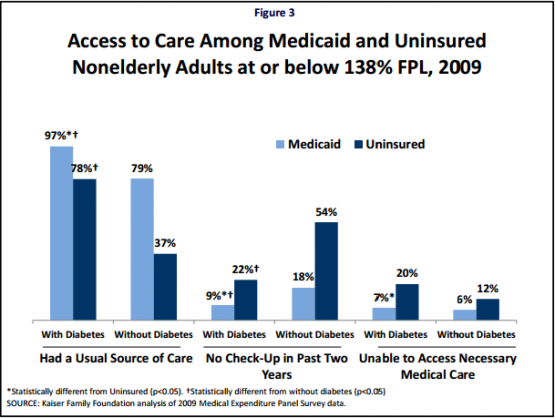November is American Diabetes Month. Nearly 26 million U.S. children and adults have the disease, and an additional 79 million Americans are either pre-diabetic or at risk for developing type 2 diabetes. The Affordable Care Act represents a crucial opportunity to extend health coverage to these Americans — particularly the low-income and minority groups that are disproportionately afflicted by diabetes. But GOP governors who have refused Obamacare’s Medicaid expansion are undermining that potential progress, leaving millions of poor diabetics without easy access to care.
Since the disease is particularly concentrated among the poor, Medicaid accounts for an outsize portion of medical spending on diabetes. In fact, the program covered 15 percent of all individuals with the disease in 2003 (the latest year for which accurate data is available), helping these sick and low-income patients afford ongoing care and treatment like insulin and preventative screenings, according to the Kaiser Family Foundation (KFF).
KFF researchers also contend that a large number of people earning up to 138 percent of the Federal Poverty Level (FPL) — who are eligible for Medicaid coverage in states participating in Obamacare’s expansion of the program — likely have pre-diabetes or undiagnosed diabetes, and therefore would benefit from basic health coverage.
But the diabetic and poor in states without Medicaid expansion won’t be so lucky. In a November 2012 study, KFF found that diabetics who are uninsured are significantly less likely to have a regular source of medical care, to have had a check-up in the past two years, or to have access to necessary medical care:

Even worse, these medically needy and uninsured Americans are forced to pay significantly higher out-of-pocket medical costs in order to manage their disease. KFF estimates that diabetics with Medicaid coverage paid an average of $177 out of their own pockets compared to the $1,498 paid by the uninsured with diabetes.
Unfortunately, many of the governors who have refused Medicaid expansion preside over states with the highest diabetes rates in the country, including Mississippi, South Carolina, Louisiana, Alabama, Tennessee, Oklahoma, and North Carolina. Those seven states all have high rates of poverty and diabetes diagnosis rates well above the national average. And without Medicaid expansion, low-income diabetics living in these red states don’t have many good options.
